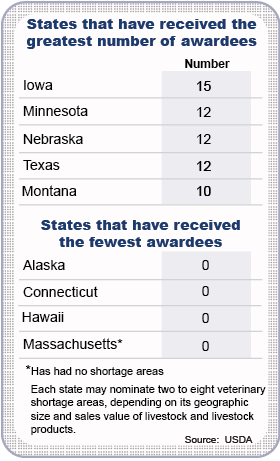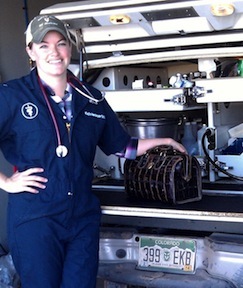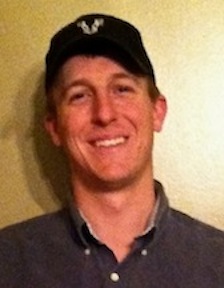Continued from page 1

Award recipient buys hometown practice
Sometimes winning a life-altering award can be a matter of timing and persistence. That’s how it worked for Dr. Zach Vosburg. The veterinarian in Hampton, Iowa, applied to the Veterinary Medical Loan Repayment Program in 2010, the year it launched. The shortage area he offered to serve was in a neighboring county. He was not selected.
Vosburg learned that he had ranked well and was encouraged to reapply. The following year, another adjacent county, nine miles away, was designated a shortage area. Vosburg tried again. This time, he made it.
Growing up in Hampton as the son of a farrier, Vosburg rode horses before he could walk. He had dogs, cats and even raccoons for pets. He and his father raised sheep; money they earned selling lambs helped pay for Vosburg’s undergraduate education.
Vosburg earned his DVM at Iowa State University in 2007, then moved near Salt Lake City to intern at a large-animal — mainly equine — specialty practice.
By then, Vosburg was married to the daughter of his high school football coach. The couple had one child and were thinking of having a second. As the internship neared an end, they decided to return to the Midwest.
“Growing up, I lived a mile from my grandparents,” Vosburg said. “I got to eat supper with them once or twice a week. The bus would sometimes drop me off there rather than at home. … I wanted the same things for my children.”
During a visit at Christmas, Vosburg asked a veterinarian friend in his hometown, a solo practitioner, whether he’d ever thought about hiring an associate. It was a fortuitous question. That spring, the practice owner offered Vosburg a job.
Accepting the position was absolutely the right thing for his family, Vosburg believed. Professionally, the move was questionable. “One-doctor mixed practice in small-town Iowa, that was a huge adjustment for me,” he said. “Financially and professionally, it was — I wouldn’t say a step backwards, but it was definitely not a step up. I had worked at a practice where we had a lot of toys. We had all of the extras, a very large client base, technicians, the whole nine yards. Going to a very small mixed-animal practice, it was good-quality medicine but with very limited diagnostic (tools) and that kind of thing.”
The pay wasn’t on par with jobs out West, either, Vosburg said, but on the other hand, the cost of living was lower.
One way to parlay the move into career advancement would be to buy into the practice but the Vosburgs figured that was a pipe dream, what with a mortgage and student loans to repay. Vosburg’s veterinary school debt alone was close to $100,000.
Then Vosburg landed the USDA award, which promised to shrink that debt by $25,000 a year for three years. All of a sudden, Vosburg and his wife, Alexis, had the wherewithal to get serious about buying the practice. And so they did. The former owner was happy to sell and swap positions — to become the associate.
Extending his practice to the adjacent shortage region, Vosburg has found, not only serves the needs of the USDA but brings the promise of growth to his own business. “Will I continue to develop clientele there? Absolutely,” he said. “We just worked a bunch of calves this morning for a set of guys in that neck of the woods that basically have started coming to us since this program began. The more often you’re there, the more often people see you and realize you’re (available).”
Vosburg also has found that practicing in a small community suits him fine. “I’m the county fair veterinarian,” he said. “I get to spend the majority of my time dealing with friends and family, clients that I thoroughly enjoy.”
In a poignant postscript to the story, the veterinarian who brought Vosburg home to Hampton died recently from cancer at the age of 56.

Photo by Brittney Perea
Dr. Kayla Henderson was offered a loan repayment award in 2013. She began her 3-year service this year working as a mixed practitioner in the San Luis Valley of Colorado, where she grew up and intends to settle.
Becoming a veterinarian was natural for Dr. Kayla Henderson, hailing as she does from a family of Colorado ranchers going back three generations. She earned a veterinary degree at Colorado State University, married a fellow “country kid” and imagined they’d settle in Pagosa Springs where her husband’s family has a small ranch.
Pagosa Springs is a picturesque town popular with tourists. Henderson’s husband, a civil engineer, had a job there he liked. Henderson considered it a good place to start her career.
She landed a position with a small animal clinic she enjoyed, although her passion is large animals. Five months later, Henderson got a call from a veterinary group back home in the San Luis Valley. The owner of a mixed animal practice had just bought a second clinic and wanted to know if Henderson would like a job.
She accepted eagerly. Located two hours and “a huge mountain pass” away, the sprawling, sparsely populated agricultural valley on the southern edge of Colorado is less affluent than Pagosa Springs, but it was home. It also happened to comprise two veterinary
shortage areas.
“I always wanted to come home,” Henderson said, “not just for the fact that it was a shortage area, but because I love it here. But the main reason I could get my husband to move over here and give it a try was because of that shortage opportunity. That was the deal I struck with him.”
Henderson applied for loan repayment assistance. She promised her husband that if the award didn’t come through, they’d leave. “He doesn’t particularly love the area,” she explained. “He was pretty much ready to pull out if I didn’t get it.”
But she got it. The news came last fall, five months after Henderson had started working in a five-doctor practice composed of veterinarians she’d known since she was a kid. For her husband, the award was a deal-maker. “That’s great,” he said. “We’ll stay here.”
“Thank goodness for it. I’m happy living close to my family,” Henderson declared, speaking by mobile phone while helping her father trim horse hooves on a zero-degree day.
The 3-year, $75,000 award will eliminate a hefty chunk of Henderson’s $102,000 veterinary school debt, and free her and her husband to start building the life of their dreams. “Looking at my debt was basically looking at a small mortgage,” she said. “We couldn’t focus on the type of life we wanted, a small ranch and room to farm. We would have had to buy a little house in town, and neither of us, that’s absolutely not who we are.”
As one of the poorest rural regions of Colorado, the valley has a modest cost of living. “Our prices are very, very low compared with anywhere else,” Henderson said, “but making a living here is tough because we can’t demand a big price for what we do.”
At one time, Henderson thought she would be an equine veterinarian, which can be lucrative. She spent eight summers in Kentucky, working most of that time for the largest equine hospital in the world. The medicine was great, but she realized she would rather live in the Rockies. In order to work with large animals there, she said, “Being a rural mixed practitioner was the only way to go.”
Back in Colorado, in addition to working with horses and other ranch animals, “we do cats and dogs and lizards and parrots and everything,” Henderson said, sounding delighted. She’s keen on the work, and she and another young associate already have talked with the owner about someday buying the practice.
Debt relief allows desired lifestyle
Photo by Larissa Baird
Dr. Brock Aiton won a loan repayment award in 2012. He works chiefly with beef cows and calves in the plains of northern Montana. Aiton recently became engaged and aspires to become a practice owner in the region.
Dr. Brock Aiton knew before he graduated from Colorado State University in 2012 that he wanted to take care of beef cows and calves. The plains of Montana seemed like a good fit, although he’d grown up in northern Arizona. And so when Aiton was offered a job with a solo practitioner who needed an associate in Chinook, Mont., 30 miles from the Canadian border, he said yes.
Making the job still more attractive was the fact that the practice happened to be located in a shortage area. With about $110,000 in veterinary school loans, Aiton appreciated the possibility of having the debt dispatched quickly. Otherwise, “It certainly would have been more tempting to try to do something more with small-animal (practice),” he said, referring to a sector with greater income potential.
Aiton started the job in June right after graduation; the USDA award came through that fall. The
shortage area is extensive — described by the state as having more than a half-million food animals spread over 26,727 square miles, amounting to 28,167 head of livestock per veterinarian — and probably could use more practitioners, Aiton said. He and his boss cover three counties, traveling as far as 160 miles to reach clients.
“It’s good to have the work, but it does take some time when you’re two hours one way to a place,” he said.
The travel is just the beginning. As he anticipated, Aiton found the days long, and the work, physically demanding. In autumn, pregnancy testing is a full-time affair. “There’s a solid month to five weeks where we test cows every day. I mean, every day, seven days a week,” Aiton said. “I had 35 or 40 days in a row without a day off.”
Not wanting to overstate it, Aiton added that the veterinarians did take half days off on Sundays.
Pregnancy checks involve moving cows through chutes, then reaching into each animal’s rectum with a hand or ultrasound probe to determine if she’s pregnant, and if so, when she’ll calve.
At the height of the season, Aiton checked 800 to 900 cows a day. His boss has been known to do 1,000 a day. “Over the course of the fall, between the two of us, we did over 30,000,” he recounted.
Despite the workload, Aiton has managed not to neglect his social life. A few months after arriving in Montana, he met Larissa Baird, a bank loan assistant from a ranching family. One thing led to another, and the couple became engaged a year later.
Aiton said he’d planned on staying with the job beyond his 3-year service period; in light of his upcoming marriage to a local, he said, “I don’t think I can leave.”
He has continued making monthly payments on his student loans, with an eye toward having the entire balance paid off by four years post graduation.
Meanwhile, Aiton’s boss, at 71, is edging toward retirement. The two have discussed the possibility of Aiton taking over the practice at that time.
In sum, Aiton said, “I couldn’t ask for any better situation, really.”
PREVIOUS 1 2